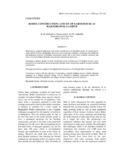| dc.contributor.author | Uz Zaman, Q.M. Mahtab | |
| dc.contributor.author | Abdullah, Q.M. | |
| dc.date.accessioned | 2010-10-13T05:11:06Z | |
| dc.date.available | 2010-10-13T05:11:06Z | |
| dc.date.issued | 2004 | |
| dc.identifier.uri | http://hdl.handle.net/10361/491 | |
| dc.description.abstract | Mud house is a typical indigenous style and is considered as an affordable means of construction to create shelter for poor. Bangladesh, due to its socio-economic condition, can harness the traditional
and indigenous practice of building construction, partly due to the easily available craftsmen and lower cost of providing affordable construction materials in rural areas.
Examining a distinct quality of earth construction in the northern part of Gazipur reveals a most innovative yet economical and environmental friendly earth construction method, termed as Rodda
construction.
This paper presents an empirical investigation into the process of making Rodda construction.
Conclusion is drawn with the objective of presenting a suitable building process. Rodda, although originates in a unique physical setting, can be alternative building construction method for affordable housing in Bangladesh, providing a technical input is given by architects. | en_US |
| dc.language.iso | en | en_US |
| dc.publisher | BRAC University | en_US |
| dc.relation.ispartofseries | BRAC University Journal, BRAC University;Vol.1, No.1,pp. 115-124 | |
| dc.subject | Rodda | en_US |
| dc.subject | Affordable housing | en_US |
| dc.subject | Sustainable construction | en_US |
| dc.subject | Indigenous material | en_US |
| dc.title | Rodda construction: a study of earth house at rajendrapur, Gazipur | en_US |
| dc.type | Article | en_US |

